I’m so excited to share this recipe for Pomegranate Bagels with you all. As soon as pomegranate season rolls around in the fall, I start dreaming up ways to use those beautiful ruby-red arils in my baking. These bagels totally deliver on that tasty pomegranate flavor in a fun and unexpected way.
The inspiration for these Pomegranate Bagels came from a new bagel shop that opened up in my neighborhood. They were serving up pomegranate bagels during the holidays and I just had to try one. The tangy-sweet taste was so good, I wanted to recreate them at home.
So I got to work developing a bagel dough recipe that incorporates pomegranate juice for subtle fruity notes in the bread. Then I toss in fresh pomegranate arils just before baking so you get delightful little pops of tartness in each bite.
The final bagels have a glorious pinkish hue and the perfect chewy yet soft texture. I like to top them off with a schmear of creamy cheese and a drizzle of honey for the ultimate breakfast treat. But they’re also fantastic for turning into sandwiches or serving as an appetizer with some smoked salmon.
Let me know if you give these Pomegranate Bagels a try. I just know you’re gonna love the sweet and tart flavor they add to your morning routine. Now let’s get to the recipe!
Contents
Why You Will Love This Pomegranate Bagels Recipe
Unique Flavor Combination: Our recipe brings together the delightful sweetness and tartness of pomegranates with the classic chewiness of bagels. The blend of these flavors creates a memorable taste experience that’s both familiar and innovative.
Impressive Presentation: The incorporation of pomegranate arils and juice not only infuses the bagels with a rich hue but also adds a visually appealing touch. These bagels are not only delicious but also beautiful to look at.
Healthful Ingredients: Pomegranates are known for their antioxidants and health benefits. By using real pomegranate juice and arils, you’re adding a nutritious twist to your breakfast or snack.

Pomegranate Bagels Ingredients and Equipment
| Ingredients | Equipment |
Dough
Boiling Bagel Water
|
|
Pomegranate Bagels Instructions
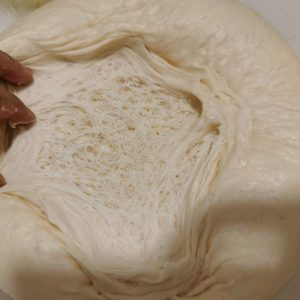
Step 1: Mixing and Fermentation
|
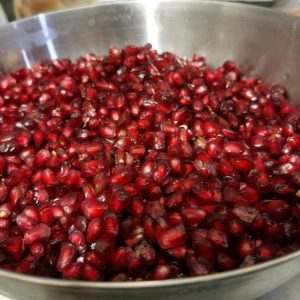
Step 2: Pomegranate PreparationPrepare the pomegranate. |
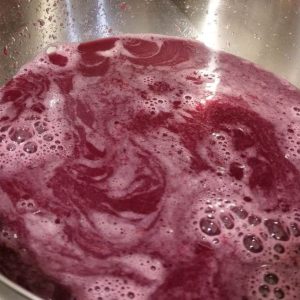
Step 3: Extract Pomegranate JuiceJuice the pomegranate |
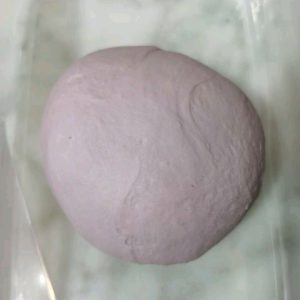
Step 4: Mixing the Dough
|
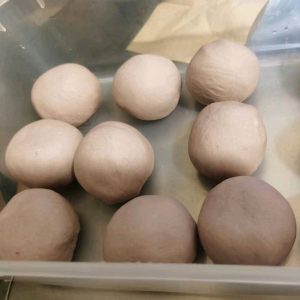
Step 5: Shaping the Dough
|

Step 6: Forming Bagels
|

Step 7: Boiling the Bagels
|
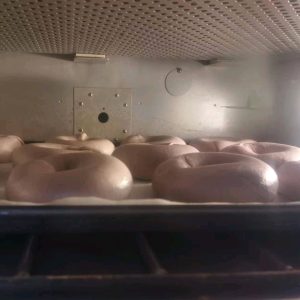
Step 8: Baking
|

Step 9: Final TouchThe bagels are ready when their surface has turned bronzed in color. Enjoy your homemade pomegranate bagels! |

Pomegranate Bagels Serving Suggestions
Here are some serving and beverage suggestions to complement your delicious pomegranate bagels:
Serving Suggestions
- Cream Cheese Spread: Classic cream cheese is a fantastic topping for bagels. You can also consider flavored cream cheese like honey, chive, or even pomegranate cream cheese for an extra touch.
- Pomegranate Arils: Sprinkle some fresh pomegranate arils on top of your bagels for a burst of color, flavor, and added texture.
- Avocado: Mash or slice some ripe avocado onto your bagels for a creamy and nutritious topping.
- Smoked Salmon: Create a delightful bagel sandwich with smoked salmon, cream cheese, capers, and red onion slices.
- Egg and Cheese: Make a bagel breakfast sandwich by adding scrambled or fried eggs along with melted cheese.
- Hummus and Veggies: Spread hummus on your bagel and top it with sliced cucumbers, tomatoes, and a sprinkle of herbs.
- Nut Butter: Try almond butter, peanut butter, or any other nut butter for a sweet and nutty twist.
Beverage Suggestions
- Freshly Brewed Coffee: A classic pairing with bagels, a cup of hot coffee complements the flavors and textures well.
- Tea: Choose from a variety of teas such as black, green, or herbal teas. They offer a lighter and soothing option.
- Fresh Juice: Freshly squeezed orange, grapefruit, or even pomegranate juice will provide a refreshing contrast to the bagels.
- Smoothies: Blend up a fruit smoothie using ingredients like bananas, berries, spinach, and a splash of pomegranate juice for an extra pomegranate kick.
- Iced Tea: If you prefer a cooler option, enjoy a glass of iced tea with a slice of lemon or a sprig of mint.
- Sparkling Water: A bubbly, lightly flavored sparkling water can cleanse the palate and provide a refreshing contrast.
- Milk or Non-Dairy Alternatives: A glass of milk, almond milk, soy milk, or any other milk alternative complements the bagels well, especially if you’re having them with sweet spreads.
- Hot Chocolate: If you’re in the mood for something sweeter, indulge in a warm cup of hot chocolate with your bagel.
Pomegranate Bagels Cooking Tips and Tricks

Use High-Quality Ingredients
Opt for fresh and high-quality ingredients, especially the pomegranate. This will enhance the flavor and texture of your bagels.
Temperature Control
Accurate temperature control during fermentation and baking is crucial. Use a kitchen thermometer to monitor the temperature precisely and make adjustments as needed.
Fermentation Time
Don’t rush the fermentation process. Allowing the dough to ferment for the recommended time helps develop better flavor and texture in the bagels.
Dough Consistency
Aim for a slightly tacky but not overly sticky dough. Adjust the flour or water as needed during the mixing process to achieve the right consistency.
Shaping Techniques
Take your time while shaping the bagels. Roll and shape the dough gently to create a smooth and even surface.
Secondary Fermentation
Proper humidity and temperature during the secondary fermentation are important. If you don’t have a controlled environment, you can create a makeshift “proofing box” by placing a tray of hot water near the bagels and covering them loosely with plastic wrap.
Boiling Technique
The boiling step gives bagels their characteristic chewy exterior. Boil each bagel for about 30 seconds on each side, ensuring they are fully immersed in the water. The addition of sugar to the boiling water adds a touch of sweetness and helps with browning.
Baking Surface
For a chewier bottom crust, bake the bagels on a preheated baking stone or steel, or directly on a baking sheet lined with parchment paper.
Steam in the Oven:
To achieve a crisp and shiny crust, create steam in the oven during the initial stages of baking. You can achieve this by placing a baking pan with water on a lower rack or spritzing the oven walls with water.
Pomegranate Bagels Storage and Shelf Life

Storage
- Room Temperature: Freshly baked bagels are best enjoyed within the first day. If you plan to consume them quickly, you can keep them at room temperature in an airtight container or a resealable plastic bag.
- Refrigeration: To extend the shelf life, you can refrigerate the bagels. Place them in an airtight container or a sealed plastic bag to prevent them from drying out. They can last in the refrigerator for up to 3 to 4 days.
- Freezing: If you want to store bagels for an even longer period, freezing is a great option. Wrap each bagel individually in plastic wrap or aluminum foil, then place them in a resealable freezer bag. They can be frozen for up to 2 to 3 months.
Thawing and Reheating
- Thawing: When you’re ready to enjoy frozen bagels, take them out of the freezer and let them thaw at room temperature. You can also microwave them briefly on a low setting to speed up the thawing process.
- Reheating: To enjoy your thawed or refrigerated bagels, you can reheat them for a few minutes in the oven at 350°F (175°C) until they are warmed through. Alternatively, you can slice the bagel and toast it in a toaster or toaster oven.
Note: When reheating or toasting, make sure not to overdo it, as bagels can become too hard or overly crispy.
| Storage Method | Shelf Life |
|---|---|
| Room Temperature | 1 day (best consumed fresh) |
| Refrigeration | 3 to 4 days |
| Freezing | 2 to 3 months |
Frequently Asked Questions

Q: Are they sweet or savory?
A: Pomegranate bagels tend to be on the sweeter side due to the fruit juice, but they can also have a slight tanginess from the pomegranate. They make a nice breakfast bagel with sweet or savory spreads.
Q: Can I use store-bought pomegranate juice for the bagels?
A: Yes, you can use store-bought pomegranate juice, but make sure it’s 100% pure juice without added sugars or additives. Freshly squeezed pomegranate juice is recommended for the best flavor.
Q: What are some good toppings for pomegranate bagels?
A: Some recommended toppings for pomegranate bagels include cream cheese, honey, jam or preserves, nut butters, hummus, smoked salmon, and avocado. Sweet or savory both work well.
Q: Can I substitute active dry yeast for instant yeast?
A: Yes, you can substitute active dry yeast for instant yeast, but you’ll need to activate it in warm water before adding it to the dough. Follow the package instructions for activating active dry yeast.
Q: What’s the purpose of boiling the bagels before baking?
A: Boiling the bagels briefly before baking sets the outer layer of dough, creating a chewy crust. It also helps develop the characteristic texture and flavor of bagels.
Q: Can I make the dough ahead of time and bake later?
A: Yes, you can prepare the dough and let it undergo its initial fermentation. Then, shape the bagels, place them in the refrigerator, and let them cold ferment for up to 24 hours before boiling and baking.
Q: My bagels turned out too dense. What went wrong?
A: Dense bagels can result from overmixing the dough or not allowing it to ferment and rise properly. Ensure you follow the mixing times and fermentation periods as mentioned in the recipe.
Q: My bagels didn’t get the shiny crust. What can I do?
A: To achieve a shiny crust, create steam in the oven during the first few minutes of baking. Place a pan of water in the oven while it preheats and keep it there during baking, or use a spray bottle to mist the oven walls with water.
Q: How do I know when the bagels are fully baked?
A: The bagels are ready when they have a golden-brown color and sound hollow when tapped on the bottom. The internal temperature should be around 200°F (93°C).
Q: Can I make mini bagels or different shapes?
A: Yes, you can make mini bagels or shape the dough into other forms. Adjust the baking time accordingly, as smaller bagels may require less time in the oven.
Q: Can I use whole wheat flour for a healthier option?
A: Yes, you can replace some or all of the all-purpose flour with whole wheat flour. Keep in mind that whole wheat flour may yield slightly denser bagels, so consider a mix of both flours for a balance of texture and flavor.
Q: How do I prevent the bagels from sticking to the baking sheet?
A: Use parchment paper or a silicone baking mat to line the baking sheet. You can also lightly grease the surface before placing the shaped bagels on it.
TRY OUR OTHER BAGEL RECIPES?
Please find them from HERE
You might also be interested in below Recipes

